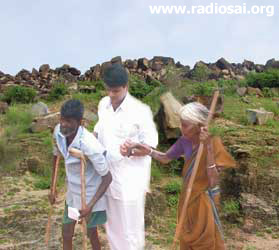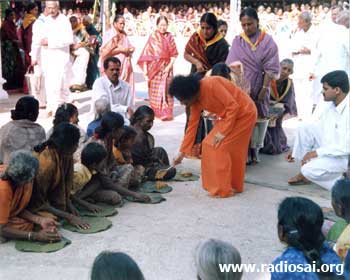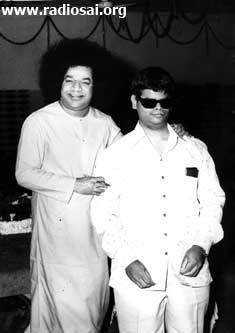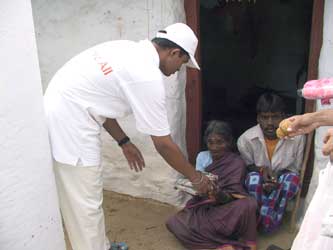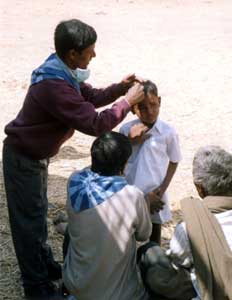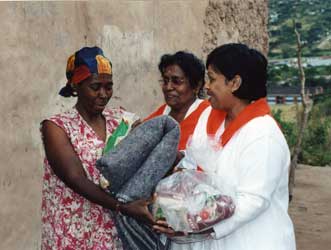Home |
SBOI-Group|
Pictures
|
Audio-Video |
Wallpapers|
Greeting-cards
|
Ashrams Info.
|
Sai news
“HANDS THAT SERVE ARE HOLIER THAN LIPS THAT PRAY”
- An enlightening panel discussion, Part 1
"Hands That
Serve are Holier than Lips That Pray”. Sounds very simple, isn’t it? Yes,
it is very pretty straightforward to understand and talk about but the
real issues arise when one tries to practice this every day, in every
situation, in every moment of ones life. Because that’s when one
encounters situations when one is unable to decide “to do or not to do”.
Given the great significance of this saying of Baba in one's daily life,
especially for the youngsters, there was a panel discussion held in the
Brindavan campus of Swami’s Institute during the “Summer Course On Indian
Culture and Spirituality” in May 2002.
The
discussion paneled by very eminent guests and staff of the Institute was a
comprehensive elaboration on this subject. We have aired this panel
discussion on Radio Sai on many occasions and many listeners have
expressed their desire to have the text of the discussion emailed to them.
For the benefit of those listeners and others who want guidance on this
subject of “Service and Prayer”, we now bring the first part of this
valuable discussion. The second part will be carried in the next issue of
H2H on November 1st.
|
|
|
The Panelists
The moderator of
the session was Prof. G. Venkataraman, eminent scientist and former Vice
Chancellor of Swami’s Institute. The panel members were -
- Prof. Anil Kumar, former
principal of Brindavan Campus of the Institute and currently a Senior Faculty
Member in the Prashanti Nilayam Campus.
- Prof. Ramamurthy, Assistant
Dean of School of Business Management, Accounting and Finance, Prashanti
Nilayam Campus.
- Sri Sanjay Sahani, formerly
warden of Prasanthi Nilayam campus and currently the Principal of Brindavan
campus of the Institute.
The Moderator’s Opening Remarks
Sai Ram. I extend
a special welcome to our distinguished guests. You already heard about the theme
of the panel discussion. It is bit of a tongue in cheek theme, if I might say
so.
First, let me
describe the way the panel discussion will be conducted. There will be several
rounds. In the opening round, the panelists will make a brief opening statement
relevant to the topic under discussion. After this I will ask the panelists
specific questions in relation to the points they have made. This will then
evolve into a dialogue followed by a general conversation. At that stage, I hope
you will be sending us questions based on what you have heard; this is an
important aspect of today’s exercise. We want you to ask questions. Write them
down and they will be collected by volunteers and I will pose them to the
panelists. At the end the panelists will make a one-minute summary statement and
the discussion will be concluded with a brief summary by myself, the moderator.
The Panel Discussion Begins…
|
|
|
The theme for today is “Hands that serve are holier than
lips that pray.” To use the words of the distinguished speaker who gave us a
very stimulating address, service can be a very important aspect of the
psycho-social evolution of mankind. Let me tell you a brief story, and then
the objectives.
The story is an incident that was narrated in the foyer of
Prashanti Nilayam Campus by a teacher many years ago. It relates to Baba
Amte, a well-known activist and social worker. In the early days of his
life, he did a tremendous amount of work for the uplift of lepers. One day a
person came and said, “You are doing so much for the lepers, you are such a
good man. Why don’t you take five minutes off and go to the temple and offer
prayers to Narayana?”
Baba Amte replied, “Why do I have to go to a temple to
worship Narayana when Narayana is coming to me all the time and asking me to
serve Him?” You may think it is a blasphemous remark, but I submit to you
that it is a remark that ought to get us thinking. While the panel
discussion is going on, I would like you to contemplate and ponder over the
following questions. |
What really is service?
When must service be done?
How exactly must service be rendered?
What are the different types of service that
one could undertake?
How must service benefit others?
And last but not least, how must service
benefit the doer?
When Swami gave
the inaugural address at the time of the Sathya Sai Educational Conference, he
started with five or six questions. In the same way I have posed before you the
questions above.
With these
remarks, I now invite the panelists to make their opening statement concerning
today’s topic with the request that they be brief. May I request each panelist
take 2.5 to 3 minutes?
I will start with
our friend Sanjay Sahani, who has a unique experience. Why don’t you tell us
something about the topic, Sanjay?
|
Prayer and Service
Sri Sanjay Sahani:
Offering my loving pranams at Bhagavan’s Lotus Feet, respected fellow panel
members, members of this august assembly.
Prayer and service are integral aspects of both the Sri
Sathya Sai Organization and the Sai Educational Institutions. It is not our
objective to discount the value of prayer, but to explore the significance
of service. Then why this statement “Hands that serve are holier than lips
that pray.”
In this context, I am reminded of a graphic description
Bhagavan gives for certain kinds of devotees of modern times. Let me give a
verbal description to you of the incident that occurred one morning. A man
was in his puja room, meditating on God: “OM Namashivaya, OM Namashivaya, OM
Namashivaya…..Mannu ki ma, dhobi aaya? [
Has the washerman come?] OM Namashivaya, OM Namashivaya OM Namashivaya,
Mannu ki ma, breakfast thayar he? [Is
the breakfast ready?] OM Namashivaya, OM Namashivaya, OM Namashivaya.”
It is a vivid description that shows for the vast majority
of people it is not possible to concentrate on God even for a few minutes.
For such people not to be wasting their time in apparent spiritual
activities service is the prescription. |
|
|
“Serve others and
you will experience spiritual joy easily, quickly.”
In our Indian
culture it is said, Paropakararam idham shariram
– The body is given to serve others. In the nine paths of devotion,
Nava Vidha Bhakti, one of the forms of
service is Pada Seva, worship of the Lotus
Feet.
What is Pada Seva?
The Purusha Sooktham says, “Padosaya vishwa bhuthani, thripathasyam rythm dhivi”
– One portion of the Lord’s splendor is this manifested universe and three
portions of it is unmanifested, transcendental.
The practical
implication of worshipping the Feet is to serve mankind, to serve the world.
Bhagavan says, “Dil mey Ram Hath mey Kam” –
“Lord in the heart, work through the hands.” There are so many organizations, so
many individuals, who do service. What is unique about Sai Service?
The uniqueness of
Sai service is the spiritual attitude which we have to look at, sometime later.
Sai Ram.
Prof. GV: Thank you Sanjay for that
good opening. The most important point he made is we are not easily geared to
bhakti (or devotion) the way it should be
practiced. To start with, he said, service is a good starting point; you can add
bhakti later on like sugar as you go along.
He made other important statements, which I hope you will remember. Now to the
one and only Anil Kumar, you have only three minutes.
Prof. Kumar: Sir, I make statements
and I don’t dare to explain. Let me say what Bhagavan has to say on the matter.
Here are three statements.
Statement 1:
Karmamuna puttunarudu – Man is born for
actions
Karmamuni vruddhichandi chanun – In the
field of action he is totally involved during his life sojourn and ultimately
ends his life.
Karmame karanamu narunaruku sukha dhukhamulalo
– Action is responsible both for bondage and liberation
Statement 2:
Karma margambu kali bata – The path of
action is something like walking along the journey
Gnana margambu vimana yanamu – The path of
knowledge is something like traveling by flight from one area to another
Bhakthi margambu bandi bata – The path of
devotion is something like traveling in a bullock cart
Yoga mana jaladhi pai odakkade – Traveling
by ship is yoga. This is what Bhagavan has described.
Statement 3:
Prayer is the
root, service is the fruit. Sai Ram.
Service is Prayer in Action and Prayer is
Communion with God
Prof. GV: Now Professor, why don’t you
increase our appetite with what you have to say?
Prof. Ramamurthy: Pranams to the Lotus
Feet of Bhagavan. Before I venture into this statement, there is an angle that
has to be resolved. Service is prayer in action. Action is communion with God.
In order that seva be properly done, it is essential that it should be done with
love and humility. In-depth prayer and a constant prayerful attitude will fill
you with love and humility and therefore for the service to be done properly, it
must flow from God’s grace arising out of prayer. Only then will you be able to
provide selfless, spontaneous service of the nature it deserves.
Unless you have
connection to the powerhouse, you can’t have the electric light. So prayer leads
you to God almighty, from where you get the faith and love, and with that armor
you can render effective, fruitful service.
Man starts his
spiritual life with an objective to see the external God in simple ways, at a
primary level. Later on he tries to see God as
Hrudayavasi, the Indweller, when he matures. And further on he sees God as
pervading all, or omnipresence. At that stage he sees God in man. That is when
service to man becomes service to God.
Mother Theresa has
what she calls a business card which she gives to those who come to her:
'The fruit of faith is prayer.
The fruit of prayer is love.
The fruit of love is service.'
Swami has also
mentioned that Lord Krishna said in the Bhagavad Gita, any devotee has got to
have these three attributes together. Tan mana
– they always perceive the Lord and enjoy the bliss in His presence ever and
keep Him in their mind; Tathbhakthi –
intense devotion to the Lord; and Thathchidhi
– you are willing to give dedicated selfless service.
Prayer, bhakti and
devotion have to be combined. They are not mutually exclusive. Depending upon
the nature of the individual and his temperament, the degree to which each can
access one or the other will vary, but these options are available to all, and
depending upon situations, they have to make the choice.
Prof. GV: Thank you, Prof. Ramamurthy.
Just to remind everyone, service is prayer in action and prayer is communion
with God. And if they go hand in hand, you can see God within you when you pray.
You can see God in the outside world and you can see God inside when you pray.
You have had three gems from our panelists. This is more than I bargained for.
The Bliss of Service
Here is a
question: Sanjay, using an example, you said service helps us focus more easily
on God than sitting in the puja room. Can you give me an example of how service
helps you focus better on God, from your own example as a teacher and as a
student?
Sri Sanjay Sahani: Who is God? God
defined is God defied. One of the descriptions of God is
Satchitananda [God is Bliss]. Service is a
means to that bliss. You asked me to narrate a personal experience. In this
context I am reminded of the first gram seva [service to villagers] we had two
years ago. In the course of gram seva, teachers were assigned duties to go one
day earlier to the villages, survey the villages, and decide on the logistics
and come back with suggestions.
|
|
|
We went in search of a particular village near Puttaparthy
and in the course of our exploration we discovered a small settlement of
about 30 to 35 houses which was not even slated for our visit. We came back
and reported to our elders. On that particular instance, we had planned to
distribute clothes to the villages in accordance with the names given to us
by the government officials, and this village was not even in the government
roles.
We requested them, “If you can give us 35 saris and dhotis
we can distribute them to the poor villagers.” They agreed. On that day, one
of my teacher brothers requested of me, “Why don’t you personally distribute
these clothes to the villagers?” Normally elders would do it, but he
requested me to do it. So we called them from their huts and they were
seated together, One by one, with innocence and humility, they received the
clothes from us. |
At that point in
time I had a strange experience, it was like being uplifted from the ground
floor of a building to the 25th floor. The joy that I experienced at that time
cannot be explained by words. It is much more than a thousand rasagullas [a
sweet delicacy] that we can have. That is experience. It was not even the
clothes that we were distributing. Swami gave us all the material, but just by
handing it over to those villagers, on that occasion, my mind was refusing to
come down from the supernatural heights it had attained. When you experience
that bliss, you know what God is, what Divinity is. Thank you, sir.
Prof. GV: Thank you Sanjay. You
brought up an important point. Ultimately, what we have to do is experience
bliss. When you experience bliss, you have experienced God.
Service offers an
easy and a simple way of experiencing bliss. Experiencing bliss from meditation
is more difficult and the point that Sanjay mentioned is that you can experience
bliss through service. I can corroborate and verify the statement; I have seen
thousands of our students experiencing this bliss.
Now, Prof. Kumar,
more about the root and fruit, how sweet it is.
Prof. Anil Kumar: When I say the word
root, I mean it is the foundation. The fruit cannot exist without the root
underneath. It is the root that finds its fulfillment in the fruit. This root
will supply all that spirit of humility, respect, reverence needed for fruition
in the form of service. Prayer is the foundation that inculcates or supplies the
spirit, the required background, reverence and respect which is needed for the
service.
This is
thriveni sangamam [confluence of the sacred
three]. In other words, root is karma yoga,
fruit is gnana yoga. In between, bhakti
yoga. As I work with all humility, I will have the experience that gives the
joy, what we call gnana (wisdom).
The first six
chapters of the Bhagavad Gita is this: what we call karma shaka, bhakti shaka,
gnana shaka. A kind of evolution, transition from the stage of action to
devotion and on to wisdom. Finally, sir, one note I would like to share from the
learned scholar this morning. What a wonderful statement: “The individual soul
is connected to the universal soul only by means of service.” Sai Ram.
Humility – the Basis of Service
Prof. GV: Thank you, Prof. Kumar. I
would like to make a brief comment on what you said for the benefit of all of
us, particularly the students.
|
Prof. Anil Kumar said when you go out for service, you
should not do so with a feeling of condescension, arrogance or pride or ego
or anything like that. There must be reverence, humility, a sense of
responsibility.
To underscore this, I would like to recall what happened at
the time of the Gujarat earthquake. Bhagavan sent relief supplies to the
people in Gujarat along with many people to distribute them and do the
needful. Many NGOs from all over the world also sent relief supplies. Mr.
Chiranjeevi Rao, though he was past 80, was personally sent by Swami to go
all the way to Gujarat. That is the confidence Swami had in Mr. Chiranjeevi
Rao. Mr. Rao told me when they arrived there, they saw the non-NGOs throwing
the blankets and food from the trucks.
The people were saying, “Why do you do this? Don’t treat us
like beggars. We are well-to-do people, we lost our house, don’t treat us
like beggars!”
In contrast, our people served those in distress with great
humility. I have a beautiful photograph of a sevadal combing the hair of a
boy sitting in a chair. Where would you see this? I thought he was giving
him a haircut. He was actually combing his hair. |
|
|
Respect, humility,
reverence, they are core to service. That is a wonderful point you brought.
Prof. Ramamurthy: In Buddhism, one
said that if you want to lead others to salvation, you have to experience it
first. Otherwise it will be the blind leading the blind. Another group of
Bodhisattvas said, “Service will take you along that path, so the higher
priority is to provide service at all costs.”
Again we must
remember that while service will take us along the direction we deserve, the
attitude becomes most important. Sanjay Sahani is deeply devoted to Bhagavan
Baba and when he renders service, love and affection flow through him.
When an
opportunity for service was given to him, he said, “This is the ultimate.” He
can have a counterpart elsewhere, of comparable age, and position. Given the
opportunity to provide a service of similar type, he might give it with an air
of condescension, a sense of arrogance. It is essential that before we do
service, ego is removed from your heart.
There are many
institutions where individuals are found of various types. One is interested in
his name being embossed as having been charitable, having made such and such
contribution. Attitude is very important.
Prayer should not
come from the lips; it should come from the heart. Service also has to flow from
feelings arising from the heart. Therefore a sense of devotion becomes
essential. Prayer is for the unmanifested. Service is for the manifested God.
Service gives you
a direct response. When you render service, you find out whether the person is
happy or not. A smile is the reward you get for service. Service provided with
the right attitude is service to God. That is what I would like to say.
Chitta Shuddhi – Purifying Your Heart
Prof. GV: What the Professor is saying
now is closely related to what our learned speaker said as
Kshara and
Akshara. Now we enter into round 3. I have a general question to all
members of the panel:
We say we are
interested in doing service. We are interested in motivating our students into
doing service, not only here but in the future as well. Let us remember we
didn’t invent service. Today there are hundreds of organizations performing
service, we cannot discount it, they have good intentions, they are doing it
with noble motives. Under the circumstances, is there any distinguishing feature
between the services rendered by others and the service that we want our
students and ourselves to do? If there is a difference, please tell us what it
is.
|
|
|
Sri Sanjay Sahani:
The fundamental difference between the service rendered by Sai students or
Sai Organizations and the service rendered by others is the spiritual
attitude. You may be familiar with the story of the stonecutters. A question
was posed to one stonecutter, “Why are you cutting stones?” He said “I am
earning my livelihood.” The same question was posed to another. He said, “I
am cutting stones; I want to be the best stonecutter around.” He wanted
professional excellence. When the third person was asked, he said, “I am
building a church for my God.” See, that is a spiritual attitude.
Why is spiritual attitude important in service? When you do
service, let us not labor under the illusion that there will not be
difficulties, there will not be hardships, and there will not be obstacles.
There will be difficulties. If you do not have a spiritual attitude it is
very easy to lose one’s moorings, to lose interest, or to meander into pride
and power. In this context, I am reminded of a dialogue from Dr. Fanibunda,
a dentist from Bombay and ardent devotee of Bhagavan. He posed this question
to Bhagavan: |
“Swami, what is
the role of the Sri Sathya Sai Seva Organization in Your mission?”
To his utter
amazement, Bhagavan said, “Nothing.”
It was so
startling!
Dr. Fanibunda
continued, “Swami…nothing?”
Swami confirmed,
“Yes…nothing.”
Dr Fanibunda
couldn’t help but ask this question: “Swami, then why is there such a huge
organization setup?”
Swami explained,
“It is only for your chitta shuddhi – purifying your heart.”
If we keep this in
mind, we will never lose our moorings when we take up service activities, we
will always remain on track on reaching the goal. This is the important and
distinguishing feature.
Prof. GV: This is a very important
factor. Someone asked Baba: “Swami, no matter how much we do, the problems of
the world still remain.” Swami replied, “You are not serving in order to solve
the problems, you are serving in order to make an offering to God and to improve
yourself.” That is the sum and substance of what Sanjay said. We are not the
NGOs, doing service with an attempt to provide relief and support and trying to
solve a problem. We are not involved in problem solving. We do try to offer
relief, and we have a higher spiritual objective.
I now request
Prof. Anil Kumar, who has a distinguished track record in Andhra Pradesh in
doing tremendous service. Drawing from your own experience, why don’t you tell
us something unique about Sai seva?
Prof. Kumar: Kindly remember these
points.
Point 1: You
should have strong desire, intense desire to do service. That is called
karma jignasa. You should know that this
karma [service] is your dharma [duty]. Service is a duty. It is not an
obligation; it is not anything remunerative, not for any selfish interest.
The next one is
dharma jignasa. You should have the feeling
that service is your duty. Karma jignasa, interested in the field of service.
Dharma jignasa, accept it as a part of your duty and then it takes you to
Brahman the divine, Brahma jignasa. Karma
jignasa takes you to dharma jignasa. From dharma jignasa, the finale happens to
be Brahma jignasa.
|
Point 2: We should know the modus operandi. How do we go
about service, how do we do it? It is the marma [secret]. So karma, dharma,
marma, Brahma, are the four steps. Marma
means the technical aspects of the service. Like one cannot serve fruits to
a diabetic patient. “I am serving you; I cannot give you mango fruits.” You
are doing disservice. I cannot carry a packet of Pulla Reddy Sweets to a
diabetic patient. I am not supposed to do it.
Doing Narayan seva, a sevadal volunteer was carrying a
basket of sweets. He went on shouting “Laddu, laddu” [sweet]. He did not
give a single laddu to a single person. There is no marma, there is no
secret. He doesn’t know the procedural aspect of it, that is the next point.
This karma, the service, what is its aim, what is its purpose? For chitta
shuddhi – the purity of the heart. |
|
|
Service elsewhere
is for statistics, for data, for publicity, propaganda, advertisement, for
enrolling more and more people, or for recognition. But here, karma is
absolutely spiritual, for your own purification. Chitta shuddhi, the purity.
Because this chitta shuddi gives you gnana shuddhi at the final stage. That is
the third point.
Service is an Opportunity
The next point is
this: we begin our service with a prayer as Sanjay said in the beginning. Grama
seva started with a prayer at every center of its activity. To quote Bhagavan
here, “Thasmai namaha karmane.” – “I bow
down to my own actions.”
Service is not a
duty, service is an opportunity. Service is a blessing, service is a
benediction. Service to fellowmen is service unto myself. Thank you, sir.
Prof. GV: Prof. Ramamurthy, do you
have anything to add?
Prof. Ramamurthy: When you talk of
serving with a sense of duty, there is a limitation about it, there is an
obligation to do the service. Service is beyond that. Service is done absolutely
freely, voluntarily, unconditionally. Swami has also explained that desire for
the result of action or expecting a return when you provide service amounts to
rajoguna. Because there is no
faida [result], let us desist from taking
the action that is tamoguna. Engaging in
seva without looking at the outcome, totally in a detached sense, is
satvaguna. This distinction will also have
to be combined.
Prof. GV: Thank
you, Prof. Ramamurthy. I recall one thing that emerged from Prof. Anil
Kumar, that service must be rendered as a duty, service must be seen as a
dharma. Before I go to a related point about dharma, which is important, I
would like to briefly narrate a story you may have heard.
Mother Theresa in Calcutta was saving a dying man from a
gutter. A tourist was passing by and said, “Jeez, I wouldn’t do that for a
million dollars. How come you’re doing it?”
Mother Theresa smiled and said, “I wouldn’t do it for a
million dollars either.”
The tourist said, “What? You won’t do it for a million
dollars?”
Mother Theresa smiled and said, “No, I won’t do it for two
million dollars.”
“But you are doing it!”
“It is different. I am doing it for God,” she said.
|
|
|
This conveys the
point that Prof. Anil Kumar made. We see service as a duty. And when we do the
duty, we are not doing it for someone else; we are doing it for God.
Dear
Reader, is this presentation inspiring? In the next issue of H2H, we will have
the second part of this presentation where the panelists will discuss issues
like – Can we serve wherever we are and whatever we do? What is the best kind
of service? Why should one part with one's hard earned money to help others?
What is the ultimate aim of service? What does Swami say is the best approach
to service? For answers to all these questions and more, look up this section
in the next issue. Thank You.
– Heart2Heart Team
source: sairadio
Home |
SBOI-Group|
Pictures
|
Audio-Video |
Wallpapers|
Greeting-cards
|
Ashrams Info.
|
Sai news
